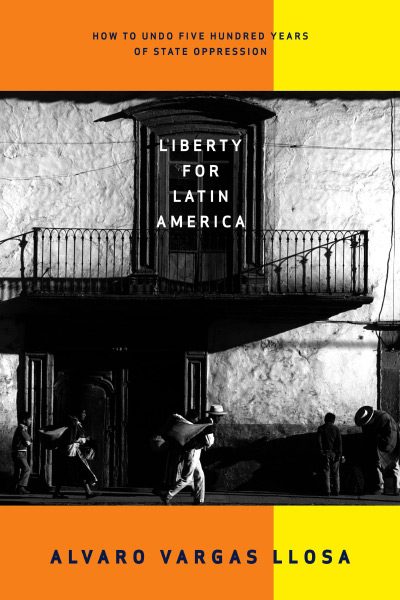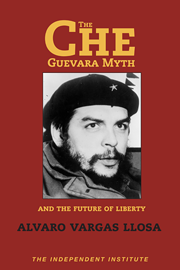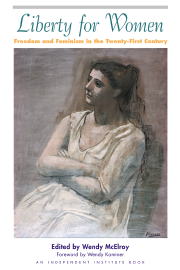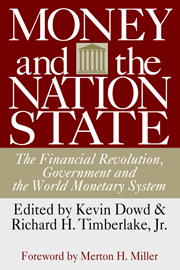| Formats |
Hardcover |
eBook |
| Formats |
Hardcover |
eBook |
Overview
In Liberty for Latin America, Alvaro Vargas Llosa offers an incisive diagnosis of Latin America’s woes—and a prescription for finally getting the region on the road to both genuine prosperity and the protection of human rights.
When the economy in Argentina—at one time a model of “free-market” reform—collapsed in 2002, experts of all persuasions asked: What went wrong? Vargas Llosa shows that what went wrong in Argentina has in fact gone wrong all over the continent for over five hundred years. Chronicling Latin America’s political and economic history, he shows how the republics of the 19th century and the revolutions of the 20th century—populist uprisings, Marxist coups, state takeovers, and First World-sponsored privatization—have all run up against the oligarchic legacy of statism. Illiberal elites backed by the U.S. and Europe have perpetuated what he calls the “five principles of oppression” in order to maintain their hold on power. The region has become “a laboratory for political and economic suicide,” while comparable countries in Asia and Eastern Europe have prospered.
The only way to change Latin America, Vargas Llosa argues, is to remove the five principles of oppression, genuinely reforming institutions and the underlying culture for the benefit of the disempowered public. In Liberty for Latin America, he explains how, offering hope as well as insight for all those who care for the future of this troubled region.
Contents
-
What Failed
-
1. The Five Principles of Oppression
2. The Twentieth Century: The Hour of the Snail
3. Friendly Fire from the United States
-
4. What Could Have Been
5. The Liberal Tradition
-
6. When Things Looked Right, They Were Wrong
7. The Fever of Change
8. The Capitalist Mirage
9. Corruption and the Ethical Abyss
-
10. Liberty for Latin America
Detailed Summary
- Latin America’s economy experienced temporary growth during the years of economic nationalism and protectionism, but ultimately the results were catastrophic. The GDP annual rate of growth between 1950 and 1980 was 7 percent for Brazil, 6.5 percent for Mexico, 4.9 percent for Peru and 3.8 percent for Argentina. By the 1980s, however, Latin America’s GDP per capita had fallen to less than one-third of the level in the core countries of the Organization for Economic Cooperation and Development (OECD).
- Three major attempts at market reforms took place in Latin America before the 1990s (one in the mid-19th century, another at the turn of the 20th century and the third under military dictatorships in the 1970s). Except in Chile for special reasons that the book discusses, all of them ended up concentrating power in an elite and keeping the masses poor. By repeating many of the mistakes made in previous attempts, Latin America missed a great opportunity in the last couple of decades.
- The crucial mistake made by governments that privatized hundreds of state companies in Latin America—more than one thousand in Mexico, more than four hundred in Argentina, more than one hundred in Peru— was to transfer assets, that is, physical entities, without transferring property rights to all citizens. This is why most of the important privatizations took place under monopoly conditions that have given privatization a bad name. Property is not a physical entity so much as a set of options that the individual can exercise.
- Contrary to conventional wisdom, so-called free-market reform did not reduce the size of government in Latin America. Argentina’s GDP grew by 40 percent in the 1990s, but public spending grew by 100 percent. Between 1996 and 2001, Brazil doubled the size of its foreign debt. Except for Chile, where the privatization of old-age pensions has boosted savings and created an important pool of capital (more than $50 billion), privatization was a missed opportunity to vest people with capital across Latin America.
- The creation of regional trade bodies (MERCOSUR being the most notable) ended up restoring many of the trade barriers that governments had set out to eliminate in the early 1990s. In Argentina, MERCOSUR meant that barriers on 71 out of a total of 97 groups of items actually went up even as Argentina was considered a model of commercial liberalization.
- Despite almost $400 billion dollars of foreign investment in the previous decade, Latin America’s investment rate is still an average of 15 percent of GDP because of the prevailing institutional climate. Hundreds of companies have moved their investments from Mexico to China because of the high costs of doing business in the former country (taxes, government-controlled energy, etc.).
- The excess of regulations has expanded the opportunity for corruption. The high cost of doing business, a problem virtually untouched by reform, has turned potential producers into candidates for lucrative government posts or government-protected markets. Brazil has more than 10 million public employees.
- Despite spending more than $25 billion during the 1990s on fighting the drug war overseas, the U.S. government concluded that Plan Colombia’s failure was a problem of scope. Therefore, in the new decade the U.S. government appropriated another $1.5 billion for Colombia’s war. Experience shows that every time a significant amount of coca plantations is eliminated in one country, coca leaves immediately crop up in a neighboring country. About 95 percent of all coca plantations eradicated in Bolivia in the last few years were recently planted. The elimination of U.S. agricultural subsidies totalling $50 billion would be a more effective way of drawing Andean peasants away from growing coca leaves.
- In Brazil, pending cases in the courts have increased ten times in the last decade, and there are more than half a million backlogged cases in the Ecuadorian courts. The absence of judicial reform has contributed to perpetuating the absence of the rule of law.
- The region’s legal systems, based on a tradition whose remote origins lie in Justinian’s codified version of Roman law and, much more significantly, in Napoleon’s positive law, give governments total discretion over everything from constitutional to economic to family matters. Under such arrangements, there is no independent judiciary.
- In order to engage in real reform, the “five principles of oppression” must be confronted. The entire body of laws should be subjected to a painstaking scrutiny that judges each law by the same standard. The standard is set by five questions: Does it relate to individuals in general or to corporations? Does it make success or failure dependent on state interference? Does it favor particular groups of people and does it therefore discriminate against the rest? Does it transfer wealth from one group of citizens to another? Does its coercive power, either to make something happen or to forbid, derive from political law, that is, from the authority of the politicians and bureaucrats who passed the norms, or, rather, from a higher principle of which those politicians were careful guardians?
- Since reform can hurt those who already depend on the government for basic services, a careful timetable and different ways to ease the transition are suggested. This includes a massive transfer of government assets to public employees and to the very poor, and a change in the legal status of shantytown organizations set up to channel government aid so that they can become incorporated and raise private capital. Also, while the transition lasts, the government should withdraw from the provision of all services, concentrating on providing the funds with which the poor will pay private providers directly, in both health and education.
In Liberty for Latin America: How to Undo Five Hundred Years of State Oppressaion, Alvaro Vargas Llosa maintains that, despite conventional wisdom, no “free market” reform has taken place in Latin America over the last decades. According to Vargas Llosa, the latest and far-reaching attempt to foster an open society in the region has run up against what he calls the “five principles of oppression”: corporatism, State mercantilism, privilege, bottom-up wealth redistribution and political law. These same principles of political, social and economic organization have been present in Latin America since time immemorial. They have been sustained, over time, by both the Left and the Right. Unless they are removed once and for all, genuine progress will not be possible.
Seeking to give a comprehensive perspective, Liberty for Latin America accounts for various reform campaigns that have taken place in the region since it gained its independence, all of which, including the most recent one in the 1990s, failed. It also compares this latest attempt with reforms undertaken in other countries, from New Zealand to Central Europe, as well as with the types of institutions that helped develop the leading nations of today.
All of the conclusions are then integrated into a final proposal for real, meaningful reform. Vargas Llosa’s proposal postulates the liberation of the individual from the coercion that has limited choice, opportunity, wealth creation and access to property in Latin America. This reform is also an attack on the deep skepticism and, at times, nihilism into which repeated failure has thrown large segments of society—the type of environment in which moral character, and therefore civil society, can hardly develop.
What Failed in Latin America
Liberty for Latin America is divided into ten chapters, following an introduction that explains how institutions and culture interact in order to bring about—or stifle—the free society. Chapter 1 looks at how five basic “principles of oppression” have shaped life in these countries from pre-Columbian to republican times.
Chapter 2 concentrates on the 20th century, up to the end of the 1980s, a period dominated by economic nationalism that ended with the collapse of the state’s legitimacy. As a result, most of the population had to operate outside of the law, and various authoritarian movements were able to rally support against the status quo and the political elites. The long descent into economic and social devastation is precisely what opened the way for reform in the final years of the century.
Chapter 3 traces the origin of development in the world’s leading nations, comparing the types of institutions that made free-market capitalism possible with Latin America’s “principles of oppression” (many of the developed nations have themselves moved away from the some of the institutions of liberty, of course).
Success, Real and Imagined
Chapter 4 delves into the tortuous relationship between the U.S. and Latin America, assessing how various types of policies (including foreign aid, double standards as regards trade, Cold War tactics, etc.), have tended to reinforce, rather than attenuate, the causes of Latin America’s underdevelopment. Vargas Llosa closely examines the war on drugs and its counterproductive effect on the whole of the Andean region.
Chapter 5 sets the stage for the following chapters, which deal with the end-of-century reforms. This particular chapter analyzes how and why previous attempts at reform failed in the region, both in the 19th and the 20th centuries. To a large extent, the same reasons that account for previous failure explain the recent failure, Vargas Llosa shows.
Reform
Chapters 6 and 7 tackle the whole reform process of the 1990s, including the fight against inflation, privatization, trade liberalization, foreign investment, and other areas. A detailed description of what took place in various countries is followed by a critique seeking to demonstrate that in no area did reform actually eliminate or substantially reduce the power of the state over the economy and social life. The moderate successes are acknowledged, but the failure to take away the monopoly of opportunity from interest groups linked to the political machinery is spelled out with a view to helping the reader understand why there has been no reduction in poverty and why frustration with “free markets” is now so pervasive in a region where reform has come to a complete stop. The conclusion is that the “principles of oppression” shaped the reform process itself, paradoxically entrenching some of the elements reform was supposed to do away with.
Chapter 8 explores corruption, both in its most blatant manifestations and in its subtle, extremely harmful social effects, which account for the absence of a cogent, morally strong, civil society. The laudable and laborious efforts by grassroots organizations and civic associations that help sustain life throughout the region are examined in the context of the pernicious effect of statism, which is responsible for the emergence of an entire underclass of marginal people devoid of any sense of social belonging and for turning social cooperation into a naked struggle for dwindling handouts at all levels.
Chapter 9 sets the stage for the final chapter, which contains the proposal for real reform. Here, the book rescues the “individualist” tradition of Latin America, valuing the manifold instances in which individual creativity, social cooperation and exchange, and resistance against political oppression have taken place throughout the centuries. This section demonstrates that real reform must rest on, and draw inspiration from, a deep-seated, ancient and therefore “legitimate” tradition, and that there is nothing alien about liberty across the region.
Turning the Tide
The final chapter of Liberty for Latin America proposes a direct attack on corporatism, State mercantilism, privilege, wealth transfer and political law through a transformation of the entire political and decision-making system based on the devolution of responsibility to the individual in all spheres of life. The type of reform proposed here has never before been undertaken in Latin America and yet it points to the satisfaction of most of the objectives that previous attempts set out to achieve. Since many individuals depend on the current system for survival, a careful transition is envisioned, including a gradual phasing out of some of the commitments of today’s governments. Underlying the entire blueprint for reform is the idea of empowering people at the grassroots level so that the various types of social institutions that are currently hindered from developing and blossoming can restore the moral fiber which society has lost and without which any sort of development is impossible.
Praise
“If you want to understand why we are poor, why a continent that should be rich has not worked, read Alvaro Vargas Llosa’s new book, Liberty for Latin America. It is not a repetitive story, nor a simple chronological connection of events, but a sharp historical and economic analysis.... Vargas Llosa solves this puzzle in a pleasant form and with abundant references, allowing all those who want to deeply understand these issues to do so.... Vargas Llosa tells us how northern European countries and the U.S. developed only when they abandoned the mercantilism that was practiced in Europe since the Middle Ages. Such a system, governed by legal positivism and ‘political law,’ is not based on the recognition of individual rights but on political connections. Under mercantilism, the citizen must serve the government and not the other way around, privileged sectors manage the country’s economy, and a continuous wealth transfer flows from the poor to the rich.”
—MANUEL AYAU CORDON, Founder, Universidad Francisco Marroquin, Guatemala
“You may not agree with everything Alvaro Vargas Llosa says in his Liberty for Latin America, but you should take very seriously his central argument: that lack of political and economic freedom is at the root of our region’s underdevelopment. With this volume, Alvaro makes an important contribution to the present debate on the causes of Latin America’s poor economic and social performance.”
—ERNESTO ZEDILLO, former President of Mexico; Director, Center for the Study of Globalization, Yale University
“There is much to admire in Alvaro Vargas Llosa’s Liberty for Latin America, not least of which its sweep, ranging across centuries of economic history from Mexico to the Southern Cone. He is especially incisive on the free market reforms that became the rage during the ’80s and ’90s, with Washington’s encouragement, but that have left intact the stagnation and crony capitalism they aimed to end. This is an intriguing manifesto, passionately argued.”
—SAMUEL DILLON, Pulitzer Prize–Winning New York Times Correspondent and former Mexico City Bureau Chief; co-author, Opening Mexico
"Alvaro Vargas Llosa might be counted among those disciples [of the Austrian school economist Ludwig von Mises] in his eloquent book, Liberty for Latin America. Llosa's impassioned review of 'How to Undo Five Hundred Years of State Oppression' does not spare the United States, which has all too often propped up 'authoritarian, corrupt, and mercantilist institutions.' For the difference between true capitalist reforms and bogus ones, Chapter 8 ('The Capitalist Mirage') makes for especially informative reading."
—BARRON'S
“Alvaro Vargas Llosa has just published a remarkable book, titled Liberty for Latin America. It is a must-read for all those who are interested in the causes of underdevelopment, and especially for those who have hopes of a remedy. Far from being an essay that goes with the wind, the young Vargas Llosa, a veteran journalist and elegant writer, has constructed his study on a solid scientific basis with an intimate knowledge of the Latin American reality.”
—PEDRO SCHWARTZ, La Vanguardia (Spain); Syndicated Columnist and President of Fundesco
“Liberty for Latin America presents Alvaro Vargas Llosa’s thoughtful analysis of what has impeded Latin America’s progress and what needs to be done. It is well worth reading.”
—LAWRENCE HARRISON, Professor, Fletcher School, Tufts University; Associate, Academy for International and Area Studies, Harvard University; Author, The Pan-American Dream
“Can Latin America overcome underdevelopment and cease to be the poorest and most hopeless segment of the West? Peruvian writer Alvaro Vargas Llosa believes that it can.... The well documented book, which is entertaining despite the topic’s density, is the fruit of two years of research at the Independent Institute in California.
“Why does ‘everything’ in Latin America usually fail? Vargas Llosa has a daring, but coherent, explanation: Neither the cultural features of Latin America nor its prevailing institutions lead to stability and a growing prosperity.”
—CARLOS ALBERTO MONTANER, The Miami Herald, Vice President of Liberal International; Syndicated Columnist and Author, Secret Report on the Cuban Revolution
“Liberty for Latin America is a gripping account of five hundred years of Latin American oppression. But it’s not just another re-cycle of that well-worn story. Far from it. Vargas Llosa marshals an impressive array of evidence to successfully make his incisive case: no rule of law, no liberty, no progress. This book is essential reading”
—STEVE H. HANKE, Professor of Applied Economics, Johns Hopkins University; Columnist, Forbes magazine
“In Liberty for Latin America, the brilliant Peruvian writer and journalist, Alvaro Vargas Llosa, relates the immense damage caused by the economic nationalism that has dominated Latin America since the Second World War.... Vargas Llosa blames the Latin American tragedy on the oppression represented by corporativism and state-mercantilism, privilege, wealth transfer and political law.”
—CARLOS BALL, El Nuevo Herald
“The citizenship demands change. But what kind of transformation do we need? The new book by Alvaro Vargas Llosa entitled Liberty for Latin America is a study that we, the Uruguayans, should pay attention to, because it is very appropriate with regard to this ‘change’ that we are calling for so stridently.”
—BÚSQUEDA (Uruguay)
“Liberty for Latin America is an analysis of how differing cultures and institutions enable or impede the emergence and flourishing of free, representative governments and broadly productive economies. It is an analysis of the causes and consequences of liberty and oppression in the history of mankind, focusing on and thus constituting the most profound, enlightening study available of Latin American history.”
—WILLIAM RATLIFF, Research Fellow and Curator of the Americas Collection, Hoover Institution, Stanford University
Author
Alvaro Vargas Llosa is one of Latin America’s foremost political journalists. A native of Peru, he graduated from the London School of Economics and has worked as a journalist in Latin America, Europe and the U.S. for over fifteen years. He is now a Senior Fellow at The Independent Institute.
He has authored twelve books, which have been published in Spanish, English, Portuguese, and Italian. He is also co-author of Guide to the Perfect Latin American Idiot, a bestseller in Latin America, Spain and the United States.















